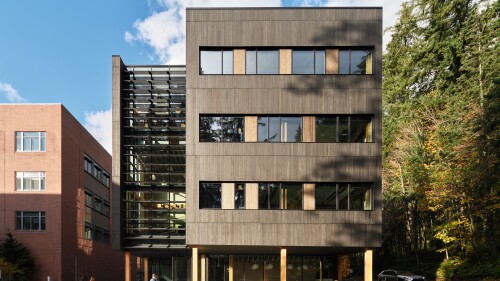A new group of real estate and energy experts is setting out to show Houston’s building owners, occupiers, and investors how to add value by subtracting energy. In March, they launched a campaign—part of a global effort—with practical strategies for cutting consumption by at least 30 percent. It will significantly improve the market competitiveness of the city’s buildings and attract investments in energy efficiency.
The campaign follows a “laboratory” held last fall that explored the barriers to energy saving in the Houston market. This private sector initiative was convened by the World Business Council for Sustainable Development (WBCSD) and its U.S. BCSD affiliate, with partners including ULI and its district council in Houston. The city is part of a global project, along with the likes of Rio de Janeiro and Shanghai, to show real estate professionals all over the world how to make properties more attractive to investors and occupants and meet climate goals.
Register for the ULI Spring Meeting
Why Energy Efficiency in Buildings Matters
Buildings are the largest energy consumers in the world, accounting for more than one-third of all final energy use and approximately 30 percent of global carbon emissions. They represent one of the key areas for action on energy security and manmade contributions to climate concerns. This is why the Energy Efficiency in Buildings (EEB) project was created in 2006 by the World Business Council for Sustainable Development (WBCSD), a CEO-led organization of some 200 global companies.
Roland Hunziker, director, sustainable buildings, at WBCSD, says: “There are plenty of financially viable energy-efficiency investments that are not being realized. EEB is working to overcome the barriers by creating partnerships that will drive action.”
Gavin Dillingham, from Houston Advanced Research Center, is managing the action platform that resulted from the EEB Lab, called “Energy Efficiency in Buildings (EEB)–Houston.” He says, “Saving energy should be a no-brainer, but a lot of people involved in urban real estate don’t know how it adds value, how to make the numbers stack up, or even how to make it happen. We have the technology, but financial, regulatory, organizational, and other nontechnical barriers get in the way, and that’s what we’re aiming to overcome.”
In this famously hot and humid city, the answer cannot be switching off the air conditioning. Nisha Desai, vice president at the smart energy company NRG told the Lab: “It’s important to differentiate between energy efficiency and energy conservation. Conservation implies sacrifice of comfort or output. Efficiency is keeping output the same, but reducing what needs to go in via efficiency improvement. It’s an important distinction.”
Houston and the World of Real Estate
The Houston “lab” brought together experts and thought leaders to challenge conventional wisdom and work out how to transform the city’s building energy efficiency. It convened more than 30 experts from organizations including Houston-based real estate firm Hines, the Institute for Market Transformation, ULI Houston, and the U.S. Green Building Council. They interviewed almost 50 experts from across the building value chain, who provided insights on barriers, enablers, and actions. The Shell Center for Sustainability produced a Market Review as background for the discussions.
Benefits for All
More energy-efficient buildings are an answer to cities’ financial and environmental goals. Houston would benefit because low-energy buildings attract the kind of young professionals Houston wants—the environmentally aware millennials who want to live and work in a “green” city. And an easily achievable 30 percent energy saving from Houston’s commercial sector alone would:
- contribute more than a half billion dollars to the Houston economy;
- avoid the need to build ten mid-sized power plants;
- create 20,000 new jobs over five years’ time in energy efficiency retrofits and other energy services; and
- substantially reduce the water needed to cool the region’s power plants—which for Texas adds up to about 120 million gallons (454 million liters) per day.
Of course, for owners and investors the question is what they get back for investing in features such as better HVAC and improved lighting and control systems. Gerald D. Hines, founder and chairman of the international real estate firm, has no doubt about the business case. In a keynote speech at the lab, he said: “When we decide to sell a building, we get the best cap rate because we have good efficiency in the way the building operates, and people know that it’s at least one of the top-rated buildings, which means a lot to financial institutions.”
One of the Houston buildings managed by Hines shows what can be done and what the owners get out of it. The 24-story office building at 1001 McKinney, between Main and Fannin streets, is nearly 70 years old and classified as Class B. But the latest of several multimillion-dollar refits puts it on a par with swanky new Class A downtown towers.
The building was featured in the Houston Business Journal, which reported that investments such as energy-efficient lighting and an energy management system have reduced operating expenses by more than $13 per square foot ($140 per sq m). And when it comes to asset value, these investments will also tempt investors by offering better capitalization rates compared with those offered by like properties that are higher energy consuming.
Investors or tenants looking for a green building do not need to delve into the intricacies of the energy management system. The U.S. Green Building Council, part of the 90-strong World Green Building Council network, has done that for them, certifying the office block Gold in its Leadership in Energy and Environmental Design (LEED) rating system.
LEED is increasingly recognized globally not only as a useful way of certifying environmental performance, but also as a prerequisite for upscale commercial property. But LEED certification is sought mainly for new construction; although as 1001 McKinney demonstrates, it can certify retrofits as well. It is entirely voluntary and pretty complex and expensive for Class B and C building owners. As a result, the certification scheme has made little headway in this part of the market, which is a key target for EEB–Houston.





